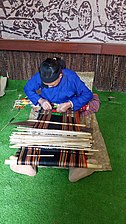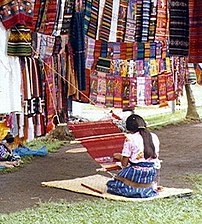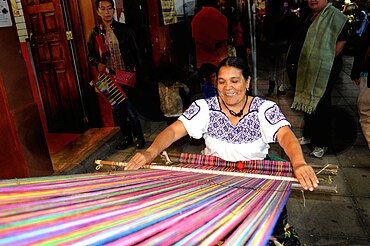
"Narrow cloth" (streit, strait, [1] narrow ware articles, narrow ware woven [2]) is cloth of a comparatively narrow width, generally less than a human armspan; precise definitions vary.
Historically, human factors and ergonomics limited the width that could practically be woven by a single weaver on a handloom. The weaver had to be able to reach both edges of the cloth, so they could throw the shuttle through the shed. A weaver thus could not weave a bolt wider than their armspan. [3] So cloth was typically made in narrow widths on narrow-width handlooms. [4] [5]
Wider widths once had to be woven with a person on each side of the loom, usually the master weaver and an apprentice, throwing the shuttle back and forth between them. [6]: 29 [3] In 1733, the flying shuttle was invented. Flying shuttles made it possible for a single hand weaver to weave widths greater than their armspan, halving the labour required to make broadcloth. [7] Fabric widths became limited by the impracticality of transporting very wide bolts and looms.
Various maximum measures of breadth were used to legally define narrow cloth, and "broadcloth" was often regulated to be twice the width of narrow cloth . The word "broadcloth" was originally used just as an antonym to "narrow cloth", but later came to mean a particular type of cloth (see broadcloth). [1] The 1909 Webster's dictionary (as reprinted in 1913) defines broadcloth as "A fine smooth-faced woolen cloth for men's garments, usually of double width". [8] thus giving both the old breadth-based distinction and the newer definition based on the type of cloth. Broadwoven and narrow woven are unambiguous terms, used by the US government. [9]
-
-
A weaver passes the shuttle through the shed of her treadle loom.
-
Weaving jamdani on a two-person loom.
-
An early fully-automated loom. The arms at the sides can be seen swinging to bash the flying shuttle back and forth.
Significance
The narrow cloth had several variations and was famous as like broadcloths;[ clarification needed] due to the narrower width, they were less prone to shrinkage[ clarification needed] and thus required less milling. [10]: 8
Historic trade definitions
In England, efforts were made to standardize the width of cloth, to promote mercery. The first on record is the Assize of Cloth (also called the Assize of Measures), which was first introduced in the reign of Richard I (1189–1199). It defined two English ells (then 74 inches, 190 cm [11][ better source needed]) as the only legal breadth for woolen cloth. Article 35 of Magna Carta reaffirmed this standard; [1] it said "There shall be standard measures of wine, ale, and corn (the London quarter), throughout the kingdom. There shall also be a standard width of dyed [generally wollen] cloth, russet, and haberject, namely two ells within the selvedges. Weights are to be standardised similarly." [12] In the reign of Edward I (1272 - 1307), an official called the king's alnager was appointed to enforce the law, and all towns were required to have an accurate ellwand (measuring stick one ell in length). [13] [1] These rules were repealed in 1353, because imports and varying types of wool made them impractical. [1] In 1665, in the reign of Charles II, the office of alnager was revived. Two standard widths were defined: widths of 2 yards (180 cm) were called broadcloth, and widths of 1 yard (91 cm), narrow cloth. The office of the alnager was abolished again in 1699. [1] See Weights and Measures Acts (UK)#England for details.
In the late-sixteen- and seventeen-hundreds, English merchants exported broadcloth to both the Levant and the Indies. This cloth was defined as having a breadth greater than a 1.25 yards (114 cm). Anything narrower was narrow cloth. [14]
James Bischoff noted in his 1842 publication, A Comprehensive History of the Woollen, and Worsted Manufactures, that British woolens were imported into Ireland with two different descriptions, broadcloth and narrow cloth. These were priced (per yard length) at six shillings fourpence and three shillings eightpence, respectively. He did not mention whether the two were distinguished by width, [15]: 326 but the doubling of price suggests that broadcloth was similar to narrow cloth except for being twice the width.
In the United States in the early 19-hundreds, fabrics with a width of less than 29 inches (74 cm) were classed as narrow cloth; wider fabrics were classed as broadcloth. [16]: 27 [5] The American 1909 Webster's dictionary (as reprinted in 1913) defines broadcloth as 1.5 yards (140 cm), and narrow cloth as 0.75 yards (69 cm), but also gives the newer definition based on the type of cloth.
In the 1990s, the US government defined "broadwoven fabrics" and "narrow woven fabrics", with a breadth cutoff of 30 centimeters (about 12 inches) (per the Harmonized Tariff Schedule of the United States). By this definition, the US government estimates that 70-75% of all cloth production globally, by weight, is broadwoven. [9]
Types and uses
Narrow-loom cloth is still made by in artisanal weaving. Traditional-format textiles in narrow widths are also machine-made. These are used from making traditional garments and other traditional textile items.
-
A museum model: hand-weaving tanmono
-
This weaver is weaving a piece of cloth about as wide as he can span. Hooghly district, West Bengal.
-
Preparing to weave geringsing on a back-strap loom. Geringseng is a culturally-significant double ikat fabric of Bali. [17] [18]
-
Weaving narrow cloth in Indonesia
-
Traditional Karen weaving, 2006
-
Weaving traditional Hlai narrow cloth
-
Weaving narrow cloth on a back-strap loom in Guatemala; finished narrow cloth is hung above
-
Traditional Chiapas weaving, Mexico.
-
Weaving bogolan in Mali. Note toggle treadles.
-
A bogolan garment.
-
Weaving adire cloth in Nigeria
-
Adire cloth for sale
-
Weaving kente in Ghana.
-
A kente garment.
-
Weaving silk in Herat, Afghanistan
-
Weaving an ornamental woolen apron in Bulgaria
-
-
Weaving on a warp-weighted loom; replica of Ancient Rome
References
- ^
a
b
c
d
e
f Chisholm, Hugh, ed. (1911). "
Alnage" (free fulltext), from the
Encyclopædia Britannica. Vol. 01 (11th ed.). Cambridge University Press. p. 719; lines two and three from end.
Owing to the introduction of the alternative standard, a distinction arose between “broadcloth” (cloth of two yards) and “streit” or “strait” (narrow cloth of one yard).
- ^ Appeals, United States Court of Customs and Patent (1971). Cases Decided in United States Court of Customs and Patent Appeals: Customs Cases Adjudged in the Court of Customs and Patent Appeals. The Court. p. 121.
- ^ a b "About the size of tanmono (a roll of kimono cloth)". hirotatsumugi.jp. Hirota Tsumugi. Archived from the original on 4 July 2020. Retrieved 27 January 2020.
- ^ Courts, Witney (England) Borough (1985). Oxfordshire Record Society. Produced for the Society by A. Sutton. pp. LXXCV, XCV. ISBN 978-0-902509-18-4.
- ^ a b Murphy, William S. (1910). The textile industries : a practical guide to fibres, yarns & fabrics in every branch of textile manufacture, including preparation of fibres, spinning, doubling, designing, weaving, bleaching, printing, dyeing and finishing. University of Massachusetts Dartmouth Claire T. Carney Library. London : The Gresham Publishing Company. p. 20.
- ^ Bodey, Hugh (1976). Textiles. Internet Archive. London : B. T. Batsford. ISBN 978-0-7134-3052-3.
- ^ "History of technology". www.historyworld.net. Retrieved 2 November 2017.
- ^ "Webster's 1913". www.websters1913.com.,
- ^ a b Freund, Kimberlie and Norton, Marjorie J.T., Broadwoven Fabrics, USITC Publication 3410: 4 ISBN 1-4289-5826-6. Free public-domain fulltext.
- ^ Brooks, Richard (1743). Observations on Milling Broad and Narrow Cloth, &c: Shewing I. The Many Destructive Errors that Attend the Common Method of Milling, and Reading Or Tighting of Cloth, During Its Milling. And, II. The Many Advantages that Accrue, Instead Thereof, from the Use of a New Instrument, Called a Regulator. To which is Annexed, A Certificate Signed by Several of the Most Eminent Clothiers in the Superfine Trade. By Richard Brooks, Clothier, Inventor of the Said Regulator, and Patentee, at the Devizes, in the County of Wilts. author in the year.
- ^ Chisholm, Hugh, ed. (1911). " Weights and Measures" (free fulltext), from the Encyclopædia Britannica. Vol. 01 (11th ed.). Cambridge University Press.
- ^ Wikisource:Magna_Carta_(trans._Davis), 1963 translation by G. R. C. Davis
- ^ AR Littlewood. "The measurements of cricket". ESPN cricinfo.
- ^ Chaudhuri, K. N. (2006-11-23). The Trading World of Asia and the English East India Company: 1660-1760. Cambridge University Press. p. 222. ISBN 978-0-521-03159-2.
-
^ Bischoff, James (1842).
A Comprehensive History of the Woollen and Worsted Manufactures, and the Natural and Commercial History of Sheep, from the Earliest Records to the Present Period. Smith, Elder.
There are two descriptions at woollen goods exported to Ireland, one broad cloth, the other narrow cloth. The average price of narrow cloth I estimate at three shillings and four pence per yard ; the lowest general price being one shilling and eight pence per yard. The average price of broad cloth exported to Ireland I should estimate at six shillings and eight pence per yard.
-
^ Baker, William Henry (1901).
Clothes dictionary;. The Library of Congress. Chicago, Ill., U.S.A., Cahn, Wampold & co. p. 27.
Narrow Cloth — Trade term for fabrics less than 29 inches wide ; wider cloths called broad
- ^ Fischer, Joseph (1979). Threads of Tradition: Textiles of Indonesia and Sarawak : Lowie Museum of Anthropology, University Art Museum, Berkeley, University of California, Berkeley, California. University of California. p. 37.
- ^ Hauser-Schaublin, Brigitta; Hauser-Schäublin, Brigitta; Nabholz-Kartaschoff, Marie-Louise; Ramseyer, Urs (1997). Balinese Textiles. Periplus Editions (HK) Limited. p. 120. ISBN 978-962-593-158-6.
External links
- Freund, Kimberlie and Norton, Marjorie J.T., Broadwoven Fabrics, USITC Publication 3410: 4 ISBN 1-4289-5826-6. Free public-domain fulltext.

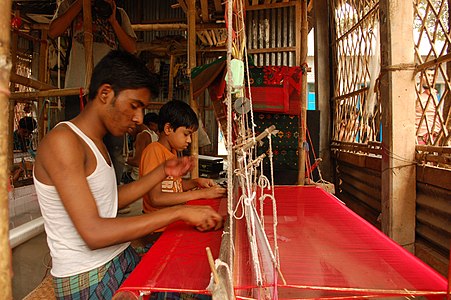


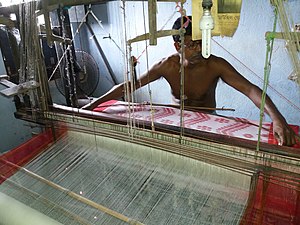

![Preparing to weave geringsing on a back-strap loom. Geringseng is a culturally-significant double ikat fabric of Bali.[17][18]](https://upload.wikimedia.org/wikipedia/commons/thumb/5/53/Geringsing_back-strap_loom.jpg/324px-Geringsing_back-strap_loom.jpg)



